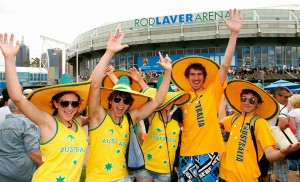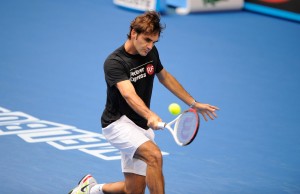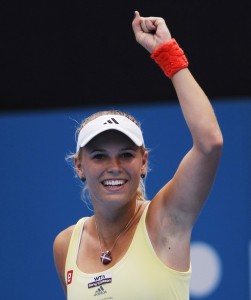by Thomas Swick
The Australian Open is the oasis in the tennis fan’s desert, coming four months after the previous grand slam and four months before the next grand slam. Watching the tournament on TV has the same restorative effect as a mid-winter vacation in the Caribbean: it is a needed reminder that there exists somewhere a land of sunshine, warmth, long days, long rallies. Into our cold, dark nights (the matches are usually shown at ungodly hours) come scenes of tanned, healthy, hatted people (and those are just the fans), visions of hard-court ballistics, and a promise of what will be ours if we can only wait a few months.

But like each of the slams, the Australian Open has its own character. While fans at the French Open are described as knowledgeable (and unforgiving), and those at Wimbledon decorous, and those at the U.S. Open extroverted, those in Melbourne are portrayed as carefree. The no-worries-mate nation has created the Happy Slam. The people’s penchant for putting on costumes reveals a Dame Edna-like distain for public opinion. Sizzling under a fierce sun they keep themselves hydrated, apparently not always with water. They hand the victor a toy koala.
Australia, despite its great tradition of tennis, always seemed a long way to go to play it. That was before Qatar and Chennai. Non-tennis fans are still fairly oblivious to the goings on down there (as they aren’t about Wimbledon or the U.S. Open), but tennis aficionados (as well as some insomniacs) watch the Australian with hungry if bleary eyes.
Like Australians, the tournament takes pleasure in upending the established order. Last January, Rafael Nadal and Roger Federer – fresh off their holiday BFF tour – came in as the kings, only to be deposed by Novak Djokovic, who went on to have a year of years, winning every slam except the French. The fact that he wasn’t Sports Illustrated’s “Sportsman of the Year” – beaten out by two college basketball coaches – was an indication not only of the sorry lack of respect for tennis but the sad parochialism of American journalism. If Mardy Fish had done what Djokovic did, you can be sure he would have won the honor. (Further boosting Djokovic’s claim to “Sportsman of the Year” is the fact that he’s the only one of the top three who smiles during matches, and occasionally applauds opponents’ shots.)

Now the tennis world is waiting to see if he can continue his domination. Federer ended the year triumphantly in London, outlasting a weary and gimpy field. It was a glorious sight for the Federer faithful, evidence of his phenomenal physical condition (the Last Man Standing had been the Oldest Man Playing) and a happy flashback to his erstwhile invincibility. But that was two months ago, and now the Cal Ripken of Tennis is nursing a back injury which caused him to pull out of the Qatar Open, with profuse apologies to the fans.
Nadal is not 100 percent (one can only guess at the last time he was), and he lost in straight sets in Qatar to Gael Monfils. He has already announced that as soon as the Australian is over he’s going to take time off to rest his shoulder.
For many number 1’s, all this would not be unpleasant news. But Djokovic is at such a high level right now that he may actually relish toying with uninjured, excuseless legends. Federer’s game, for all its beauty and grace, seems already to be of an older, less ferociously-ripped time. (At least his one-handed backhand does.) In fact, the biggest challenge to Djokovic may come from Jo-Wilfried Tsonga, who has good memories of the Australian Open.
Life’s more complicated on the women’s side. Serena Williams and Kim Clijsters are both ailing (ankle and hip), though at least the Belgian appears to still like tennis. Neither of them is in the Top 10, though none of the Top 10 players would be overjoyed to find them in her draw.

The Big 10 is comprised of a percolating mix of Slavs, immigrant Slavs, and three pesky non-Slavs. Everyone is still waiting to see if world number 1 Caroline Wozniacki (from the immigrant group) can win a grand slam. Everyone, that is, except most of Australia, which would like nothing better than to see its Sheila, Samantha Stosur, do in Melbourne what she did in New York.
Will she be able to handle the pressure of playing in front of her bewigged and face-painted compatriots? Will Wozniacki get the monkey off her back and the koala in her hands? Will the literate Andrea Petkovic surprise everyone by winning the tournament and then quoting Clive James? (Though probably not his poem, “Bring Me the Sweat of Gabriela Sabatini.”) Whatever happens, it will be worth staying up to watch it.
